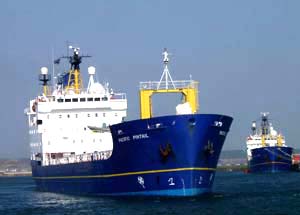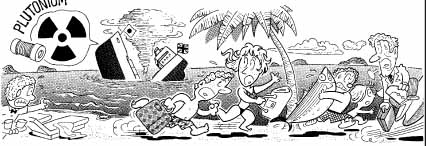A shipment of MOX (mixed plutonium and uranium oxide) fuel bound for Japan left the port of Cherbourg in France on March 5. As predicted, the ships (PNTL's Pacific Pintail and Pacific Heron) will go around South Africa, through the Tasman Sea between Australia and New Zealand and up through the islands of the Pacific.
 |
|
Pacific Pintail
|
None of this information was going to be released. On November 18, 2008, a Kyodo News article said, "The Federation of Electric Power Companies of Japan will basically stop releasing the names of freighters carrying MOX fuel, made from spent nuclear fuel, as well as shipping routes, and departure and arrival dates until transportation is complete...." However, on January 28, Areva issued a press release saying, "The hour of departure from Europe to Japan, as well as the maritime route to be used, will be made public the day after the departure." We suspect that the level of secrecy was relaxed because of complaints by en-route countries about the lack of information.
We understand that this shipment is carrying a cargo of 1.7 tons of plutonium in 65 assemblies of MOX fuel. That makes it the biggest plutonium shipment ever. There was a shipment of 1.5 tons (Pu total) in the form of plutonium dioxide powder from France on the Akatsuki Maru in 1992. That shipment aroused massive protests from en-route countries. Since then, there have been two shipments carrying plutonium from France and the UK. These shipments were carried out in 1999 and 2001 and the plutonium was in the form of MOX fuel. The MOX fuel from the UK was shipped all the way back in 2002 after it was revealed that quality control data for had been fabricated. None of the plutonium shipped from Europe has ever been used.
The MOX fuel being shipped this time is for Kyushu Electric's Genkai-3 reactor (PWR, 1,180 MW) in Saga Prefecture (16 assemblies), Shikoku Electric's Ikata-3 reactor (PWR, 890 MW) in Ehime Prefecture (21 assemblies), and Chubu Electric's Hamaoka-4 reactor (BWR, 1,137 MW) in Shizuoka Prefecture Prefecture (28 assemblies). The assemblies are transported in casks, which weigh around 100 metric tons each, including the fuel assemblies. They will be off-loaded directly at the ports alongside the Genkai and Ikata plants and at the Omaezaki port, about 3 kilometers from the Hamaoka plant.
If this shipment goes smoothly and, unlike previous occasions, the fuel is loaded into reactors, it can be expected that it will be the first of many such shipments. There is around 38 tons of plutonium held in Europe and the Japanese power companies are obliged to take it all back. At a time when the threat of terrorism, including ship hijackings, has reached unprecedented proportions, shipping all this plutonium around the world represents an unacceptable security risk. On this occasion the two ships each have guns and are supposed to be able to protect each other, but we doubt the effectiveness of the security measures.
There are three possible routes, excluding the Suez Canal: through the Panama Canal, around Cape Horn in South America, and around the Cape of Good Hope in South Africa up through the Pacific (the "Pacific route"). As part of a campaign led by Kyoto-based Green Action, CNIC staff joined other activists in visits to embassies of potential en-route countries to encourage them to lodge protests with the Japanese government. We were impressed by the depth of concern felt by many of these countries.
Shipping a cargo of plutonium through the Panama Canal presents particularly grave security risks and Chile and Argentina are viscerally opposed to shipments around Cape Horn. Chile has a law outlawing such shipments through its Exclusive Economic Zone (EEZ). It has even dispatched a gunboat to force vessels carrying radioactive waste out of its EEZ. Most of the countries we visited along these two routes were vehement in their opposition to these shipments. They have been inflicted with repeated shipments of high-level radioactive waste so they are very of aware of the issue. The Jamaican representative said that they constantly mention the issue in discussions with the Japanese government.
That leaves the Pacific route, the route taken by previous plutonium shipments. Pacific Island states varied in their responses to our representations. We got the impression that the Japanese government and power companies had gone to great lengths to suppress the opposition of some of these countries. For others, however, no amount of arm-twisting could bring them round. The whole economy of island states such as Micronesia depends on fishing and tourism. They are well aware that the damage to their reputation by even a very small accident could be devastating.
 |
|
Cartoon by Shoji Takagi published in Fiji newspapers in 1999.
|
There are serious concerns about safety. Transport casks must be able to withstand a 9-meter drop without a nuclear chain reaction ("criticality") occurring, even if the transport cask leaks and the fuel is immersed in water. (Expansion of the fuel pin lattice and the presence of water increase the chance of criticality.) The criticality assessment assumes that the fuel assemblies are in sound condition. However, MOX fuel produces heat and reaches as much as 300oC during transportation. Heat weakens the fuel assemblies, but this is not adequately reflected in the criticality assessment.
The Japanese government's response is that the five operators of pressurized water reactors and Nuclear Fuel Transport Co., Ltd. carried out drop-tests on a cask containing one full size fuel assembly. (The fuel pellets themselves were replaced by a lead-based alloy.) Although this mock-up assembly was not subjected to 300oC temperature, the assessment of the test results took into account the effects of heat-induced weakening. The companies concluded that the amount of deformation was insufficient to give rise to criticality, but given the artificial nature of the assessment, doubts remain.
There are also problems with other standards that these shipments are required to meet. The International Atomic Energy Agency' (IAEA) Regulations for the Safe Transport of Radioactive Material (2005 Edition) require that transport containers be exposed to a thermal environment equivalent to a 800oC fire for 30 minutes. They must also undergo a water immersion test "under a head of water of at least 15 m for a period of not less than eight hours". An "enhanced water immersion test" requires that they be immersed "under a head of water of at least 200 m for a period of not less than one hour". Clearly these tests do not reflect the worst-case conditions of a fire on board the ship or if the ship sank.
The following quote from a letter by the late Paul Leventhal, former President of the Nuclear Control Institute, shows that these are realistic scenarios that should be taken into account. The letter, dated December 22, 1997, was sent to en-route countries concerning an imminent shipment of intensely radioactive waste from France to Japan.
The hazards of shipping radioactive material by sea are very real. Last month, a container ship carrying highly radioactive cesium was split in two in a storm in the Atlantic Ocean. The fore section went to the bottom with its cesium packages. French regulatory authorities acknowledged the cesium containers would rupture at 3,000 meters, the depth at which the wreckage finally came to rest, but also announced they would not salvage the radioactive cargo. Lloyd's List, a shipping-trade newspaper, editorialized that the sinking of the ship, the MSC Carla, is "a stark reminder of what can be done by the sheer force of the elements upon a ship which, when she was built, was the last word in strength and power."
In our visits to Embassies we suggested actions that en route countries could take. The following suggestions were based on a 28 May 2006 Greenpeace briefing, "Nuclear Transport Briefing to the ACP Council of Ministers", Port Moresby, 28 May - 2 June:
- call for a moratorium on all shipments of nuclear fuel and nuclear waste until a regime is in place which ensures the protection of the marine environment and the environment, economy and population of coastal states;
- investigate alternative measures to protect coastlines, populations, environment and economies, including full environmental impact assessment, prior notification, emergency contingency plans, and assurance that shipping states will not transit the EEZ of coastal states;
- protest the lack of suitable security and demand full security from attacks;
- demand the development of a fully adequate liability and compensation regime.
This MOX shipment is part of Japan's failed nuclear fuel cycle program. The government's claim that plutonium will be consumed in Japan's light water reactors is used to justify the Rokkasho Reprocessing Plant. Blocking this and future MOX shipments will not only protect en route states and the marine environment, it will also help bring an end to Japan's unsustainable, uneconomic, unsafe and proliferation-prone plutonium program.
Philip White (NIT Editor)
Return to NIT 129 contents
Go to CNIC's page on MOX and pluthermal.

